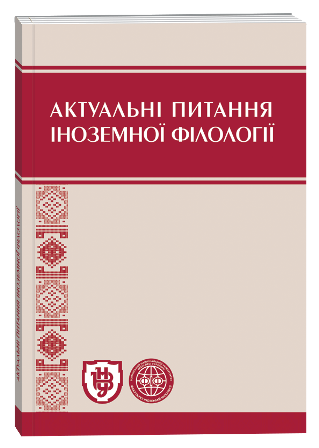THE PRAGMATIC ASPECT OF UTTERANCES OF INDIGNATION
Keywords:
speech act of indignation, expressive, constative, quesitive, directive, commissive, metacommunicative, performativeAbstract
The article deals with the pragmatic characteristics of utterances of indignation. The speech act of indignation (SAI) verbalizes the emotion of indignation and is emotive by nature. According to the illocutionary goal, we consider a SAI as an expressive or as a hybrid speech act, the hybrid nature of which is manifested in its ability to simultaneously perform the function of expressing the emotion of indignation and the function of such speech acts as constatives, quesitives, directives, commissives, metacommunicatives and performatives. The illocutionary goal of expressives is to express the speaker’s psychological state specified in the sincerity condition about a state of affairs specified in the propositional content. SAI-expressives express the speaker’s indignation at the real state of affairs and are characterized by the use of emotive structures and lexemes with a negative emotionalevaluative connotation. The pragmatic meaning of the SAI-constative is to state the indignation of the speaker caused by a state of affairs specified in the propositional content. In many cases, the SAI-quesitives are rhetorical questions, which the speaker does not use to obtain information, but to convey it in a particularly expressive form. In some cases, an indignant speaker asks a question and then answers it himself/herself, without waiting for the response of the interlocutor. With the help of SAI-directives an indignant speaker makes the interlocutor or a third party correct their behaviour, which is evaluated negatively by the speaker. SAI-menasives as a part of SAI-commissives are used by an indignant speaker when he/she intends to exert a strong psychological influence on the addressee. The research has revealed metacommunicative speech acts such as SAI-establishing, SAI-maintaining, and SAI-disconnecting of speech contact. The speaker uses SAI-performatives to express the emotional state of indignation, aimed at humiliating a communicative partner.
References
Austin, John Langshaw. 1962. How to do things with words. Oxford: Clarendon Press.
Ballmer, Thomas T, and Waltraud Brennenstuhl. 1981. “Speech Act Classification. A study in the lexical analysis of English speech activity verbs”. Language and Communication. Berlin-Heidelberg-New York: Springer Verlag.
Batsevych, Floriy. 2004. Osnovy komunikatyvnoyi linhvistyky. Kyyiv: Akademiya.
Bezuhla, L. R. 2012. “Linhvistychna prahmatyka ta dyskursyvnyy analiz”. Studia philological 1: 95–100.
Botvinko-Botyuk, Olena. 2014. “Strukturno-semantychni ta komunikatyvno-prahmatychni osoblyvosti vyslovlen prezyrstva (na materiali anhlomovnoho khudozhnoho dyskursu)”. PhD diss., Chernivtsi.
Boychuk, Valentyna. 2018. “Reprezentatsiya fenomenu pesymizmu v suchasniy anhliyskiy movi”. PhD diss., Lviv.
Bronnikova, Evgeniya. 2008. “Emotsionalnost’ i struktura rechevogo akta v tekste khudozhestvennogo proizvedeniya (na materiale angliyskogo yazyka)”. PhD diss., Abakan.
Chernyak, Oksana. 2009. “Strukturno-semantychni ta komunikatyvno-prahmatychni osoblyvosti vyslovlen osudu (na materiali anhlomovnoho khudozhnoho dyskursu)”. PhD diss., Chernivtsi.
Formanovskaya, N. I. 1998. “K utochneniyu ponyatiya «ekspressivnyye rechevyye akty»”. Russkiy yazyk za rubezhom 4:40–45.
Fraser, Bruce. 1975. “Hedged performatives.” Syntax and Semantics, edited by P. Cole, J. L. Morgan. New York: Academic Press, 3:187–210.
Habermas, Jürgen. 1984. “The Theory of Communicative Action”. Reason and the Rationalization of Society. Boston: Beacon Press.
Jakobson, Roman. 1960. “Linguistics and poetics”. Style in language. MA: MIT Press, 350–377.
Kozyarevych, Liana. 2006. “Verbalni y neverbalni zasoby empatyzatsiyi dialohichnoho dyskursu (na materiali anhlomovnoyi prozy 20 stolittya)”. PhD diss., Kyiv.
Kyselyuk, Nataliya. 2009. “Verbalni ta neverbalni zasoby aktualizatsiyi emotsiynoho stanu radosti v khudozhniomu dyskursi (na materiali anhlomovnoyi prozy 20-21stolit)”. PhD diss., Kyiv.
Ostin, Dzh. L. 1986. “Slovo kak deystviye”. Novoye v zarubezhnoy lingvistike, edited by B. Yu. Gorodetskiy. Moskva: Progress, 17: 22–129.
Pocheptsov, Georgiy. 1981. “Pragmatika predlozheniya”. Teoreticheskaya grammatika sovremennogo angliyskogo yazyka. Moskva: Vysshaya shkola, 271–278.
Serl’, Dzh. 1986. “Klassifikatsiya illokutivnykh aktov”. Novoye v zarubezhnoy lingvistike, edited by B. Yu. Gorodetskiy. Moskva: Progress. 17: 170–194.
Shevchenko, Irina. 1998. Istoricheskaya dinamika pragmatiki predlozheniya: angliyskoye voprositelnoye predlozheniye 16–20 vv. Kharkov: Konstanta.
Soloviova, Ekaterina. 2013. “Funktsionalno-pragmaticheskiy potentsial rechevogo akta vozmushcheniya v sovremennom nemetskom politicheskom diskurse”. PhD diss., Nizhniy Novgorod.
Trofimova, Nella. 2008. Ekspressivnyye rechevyye akty v dialogicheskom diskurse. Semanticheskiy, pragmaticheskiy, grammaticheskiy analiz.
Volf, Elena. 2002. Funktsionalnaya semantika otsenki. Moskva: Editorial URSS.
Yakishchenko, Elizaveta. 2014. “Vozmushchayushchayasya yazykovaya lichnost: kommunikativnopragmaticheskiy podkhod: na materiale angliyskogo i frantsuzskogo yazykov”. PhD diss., Kemerovo.
Weigand, Edda. 1989. Sprache als Dialog. Sprechakttaxonomie und kommunikative Grammatik. Tübingen: Niemeyer.







